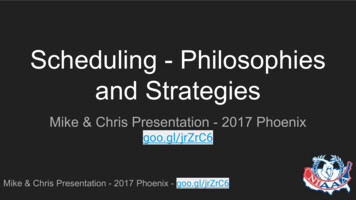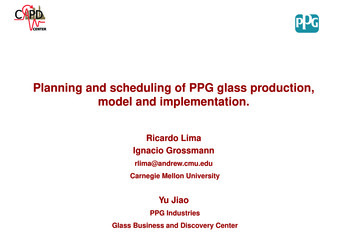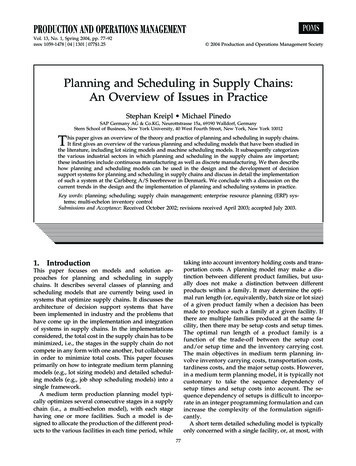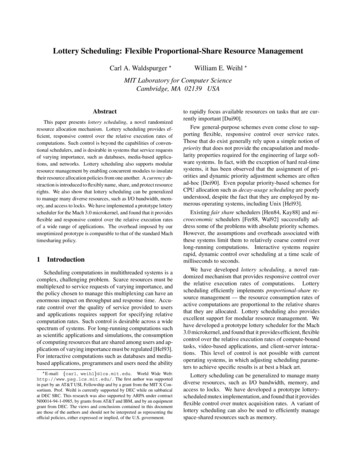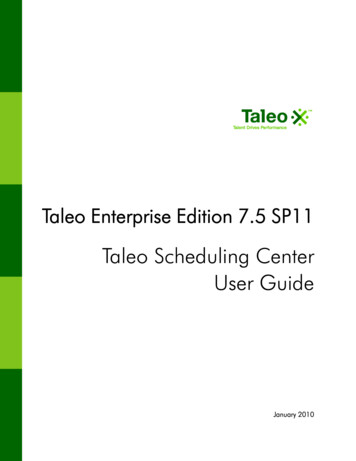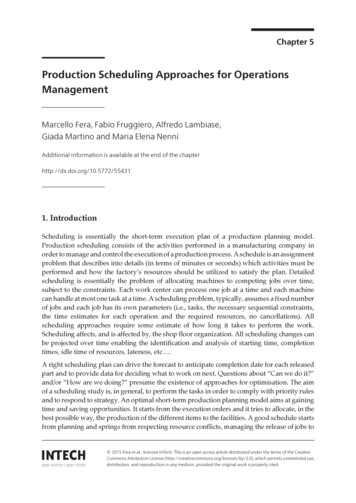
Transcription
Chapter 5Production Scheduling Approaches for OperationsManagementMarcello Fera, Fabio Fruggiero, Alfredo Lambiase,Giada Martino and Maria Elena NenniAdditional information is available at the end of the chapterhttp://dx.doi.org/10.5772/554311. IntroductionScheduling is essentially the short-term execution plan of a production planning model.Production scheduling consists of the activities performed in a manufacturing company inorder to manage and control the execution of a production process. A schedule is an assignmentproblem that describes into details (in terms of minutes or seconds) which activities must beperformed and how the factory’s resources should be utilized to satisfy the plan. Detailedscheduling is essentially the problem of allocating machines to competing jobs over time,subject to the constraints. Each work center can process one job at a time and each machinecan handle at most one task at a time. A scheduling problem, typically, assumes a fixed numberof jobs and each job has its own parameters (i.e., tasks, the necessary sequential constraints,the time estimates for each operation and the required resources, no cancellations). Allscheduling approaches require some estimate of how long it takes to perform the work.Scheduling affects, and is affected by, the shop floor organization. All scheduling changes canbe projected over time enabling the identification and analysis of starting time, completiontimes, idle time of resources, lateness, etc .A right scheduling plan can drive the forecast to anticipate completion date for each releasedpart and to provide data for deciding what to work on next. Questions about “Can we do it?”and/or “How are we doing?” presume the existence of approaches for optimisation. The aimof a scheduling study is, in general, to perform the tasks in order to comply with priority rulesand to respond to strategy. An optimal short-term production planning model aims at gainingtime and saving opportunities. It starts from the execution orders and it tries to allocate, in thebest possible way, the production of the different items to the facilities. A good schedule startsfrom planning and springs from respecting resource conflicts, managing the release of jobs to 2015 Fera et al.; licensee InTech. This is an open access article distributed under the terms of the CreativeCommons Attribution License (http://creativecommons.org/licenses/by/3.0), which permits unrestricted use,distribution, and reproduction in any medium, provided the original work is properly cited.
114Operations Managementa shop and optimizing completion time of all jobs. It defines the starting time of each task anddetermines whatever and how delivery promises can be met. The minimization of one or moreobjectives has to be accomplished (e.g., the number of jobs that are shipped late, the minimi‐zation set up costs, the maximum completion time of jobs, maximization of throughput, etc.).Criteria could be ranked from applying simple rules to determine which job has to be processednext at which work-centre (i.e., dispatching) or to the use of advanced optimizing methodsthat try to maximize the performance of the given environment. Fortunately many of theseobjectives are mutually supportive (e.g., reducing manufacturing lead time reduces work inprocess and increases probability to meeting due dates). To identify the exact sequence amonga plethora of possible combinations, the final schedule needs to apply rules in order to quantifyurgency of each order (e.g., assigned order’s due date - defined as global exploited strategy;amount of processing that each order requires - generally the basis of a local visibility strategy).It’s up to operations management to optimize the use of limited resources. Rules combinedinto heuristic1 approaches and, more in general, in upper level multi-objective methodologies(i.e., meta-heuristics2), become the only methods for scheduling when dimension and/orcomplexity of the problem is outstanding [1]. In the past few years, metaheuristics havereceived much attention from the hard optimization community as a powerful tool, since theyhave been demonstrating very promising results from experimentation and practices in manyengineering areas. Therefore, many recent researches on scheduling problems focused on thesetechniques. Mathematical analyses of metaheuristics have been presented in literature [2, 3].This research examines the main characteristics of the most promising meta-heuristicapproaches for the general process of a Job Shop Scheduling Problems (i.e., JSSP). Being aNP complete and highly constrained problem, the resolution of the JSSP is recognized as akey point for the factory optimization process [4]. The chapter examines the soundness andkey contributions of the 7 meta-heuristics (i.e., Genetics Approaches, Ants Colony Optimiza‐tion, Bees Algorithm, Electromagnetic Like Algorithm, Simulating Annealing, Tabu Searchand Neural Networks), those that improved the production scheduling vision. It reviewstheir accomplishments and it discusses the perspectives of each meta approach. The workrepresents a practitioner guide to the implementation of these meta-heuristics in schedul‐ing job shop processes. It focuses on the logic, the parameters, representation schemata andoperators they need.2. The job shop scheduling problemThe two key problems in production scheduling are „priorities“ and „capacity“. Wight (1974)described scheduling as „establishing the timing for performing a task“ and observes that, in1 The etymology of the word heuristic derives from a Greek word heurìsco (єΰρισκω) - it means „to find“- and is consideredthe art of discovering new strategy rules to solve problems. Heuristics aims at a solution that is „good enough“ in acomputing time that is „small enough“.2 The term metaheuristc originates from union of prefix meta (μєτα) - it means „behind, in the sense upper levelmethodology“ – and word heuristic - it means „to find“. Metaheuristcs’ search methods can be defined as upper levelgeneral methodologies guiding strategies in designing heuristics to obtain optimisation in problems.
Production Scheduling Approaches for Operations ring firms, there are multiple types of scheduling, including the detailed schedulingof a shop order that shows when each operation must start and be completed [5]. Baker (1974)defined scheduling as „a plan than usually tells us when things are supposed to happen“ [6].Cox et al. (1992) defined detailed scheduling as „the actual assignment of starting and/orcompletion dates to operations or groups of operations to show when these must be done ifthe manufacturing order is to be completed on time“[7]. Pinedo (1995) listed a number ofimportant surveys on production scheduling [8]. For Hopp and Spearman (1996) „schedulingis the allocation of shared resources over time to competing activities“ [9]. Makowitz and Wein(2001) classified production scheduling problems based on attributes: the presence of setups,the presence of due dates, the type of products.Practical scheduling problems, although more highly constrained, are high difficult to solvedue to the number and variety of jobs, tasks and potentially conflicting goals. Recently, a lotof Advanced Production Scheduling tools arose into the market (e.g., Aspen PlantTM Sched‐uler family, Asprova, R2T – Resourse To Time, DS APS – DemandSolutions APS, DMS –Dynafact Manufacturing System, i68Group, ICRON-APS, JobPack, iFRP, Infor SCM, Schedu‐lePro, Optiflow-Le, Production One APS, MQM – Machine Queue Management, MOM4, JDAsoftware, Rob-ex, Schedlyzer, OMP Plus, MLS and MLP, Oracle Advanced Scheduling, OrtecSchedule, ORTEMS Productionscheduler, Outperform, AIMMS, Planet Together, Preactor,Quintiq, FactoryTalk Scheduler, SAP APO-PP/DS, and others). Each of these automaticallyreports graphs. Their goal is to drive the scheduling for assigned manufacturing processes.They implement rules and optimise an isolated sub-problem but none of the them will optimisea multi stage resource assignment and sequencing problem.In a Job Shop (i.e., JS) problem a classic and most general factory environment, different tasksor operations must be performed to complete a job [10]; moreover, priorities and capacityproblems are faced for different jobs, multiple tasks and different routes. In this contest, eachjob has its own individual flow pattern through assigned machines, each machine can processonly one operation at a time and each operation can be processed by only one machine at atime. The purpose of the procedure is to obtain a schedule which aims to complete all jobs and,at the same time, to minimize (or maximize) the objective function. Mathematically, the JSScheduling Problem (i.e., JSSP) can be characterized as a combinatorial optimization problem.It has been generally shown to be NP-hard3 belonging to the most intractable problemsconsidered [4, 11, 12]. This means that the computation effort may grow too fast and there arenot universal methods making it possible to solve all the cases effectively. Just to understandwhat the technical term means, consider the single-machine sequencing problem with threejobs. How many ways of sequencing three jobs do exist? Only one of the three jobs could bein the first position, which leaves two candidates for the second position and only one for thelast position. Therefore the no. of permutations is 3!. Thus, if we want to optimize, we need toconsider six alternatives. This means that as the no. of jobs to be sequenced becomes larger(i.e., n 80), the no. of possible sequences become quite ominous and an exponential functiondominates the amount of time required to find the optimal solution [13]. Scheduling, however,3 A problem is NP-complete if exists no algorithm that solves the problem in a polynomial time. A problem is NP-hardif it is possible to show that it can solve a NP-complete problem.115
116Operations Managementperforms the definition of the optimal sequence of n jobs in m machines. If a set of n jobs is tobe scheduled on m machines, there are (n!)m possible ways to schedule the job.It has to undergo a discrete number of operations (i.e., tasks) on different resources (i.e.,machines). Each product has a fixed route defined in the planning phase and followingprocessing requirements (i.e., precedence constraints). Other constraints, e.g. zoning whichbinds the assignment of task to fixed resource, are also taken into consideration. Each machinecan process only one operation at a time with no interruptions (pre-emption). The schedulewe must derive aims to complete all jobs with minimization (maximization) of an objectivefunction on the given production plant.Let: J { J 1, J 2, ., J n } the set of the job order existing inside the system; M {M 1, M 2, ., M m} the set of machines that make up the system.JSSP, marked as Πj , consists in a finite set J of n jobs { J i }ni 1. Each Ji is characterized by a manu‐facturing cycle C L i regarded as a finite set M of m machines {M k }km 1 with an uninterruptedprocessing time τik . J i , i 1, , n , is processed on a fixed machine mi and requires a chainof tasks Oi1, Oi2, ., Oimi , scheduled under precedence constraints. Oik is the task of job J iwhich has to be processed on machine M k for an uninterrupted processing time period τik andno operations may pre-empted.To accommodate extreme variability in different parts of a job shop, schedulers separateworkloads in each work-centres rather than aggregating them [14]. Of more than 100 differentrules proposed by researchers and applied by practitioners exist, some have become commonin Operations Management systems: First come- First served, Shortest Processing Time,Earliest Due Date, Slack Time Remaining, Slack Time Remaining For each Operation, CriticalRatio, Operation Due Date, etc. [15]. Besides these, Makespan is often the performance featurein the study of resource allocation [16]. Makespan represents the time elapsed from the startof the first task to the end of the last task in schedule. The minimisation of makespan arrangestasks in order to level the differences between the completion time of each work phase. It triesto smooth picks in work-centre occupancy to obtain batching in load assignment per time.Although direct time constraints, such as minimization of processing time or earliest due date,are sufficient to optimize industrial scheduling problems, for the reasons as above theminimization of the makespan is preferable for general/global optimization performancesbecause it enhances the overall efficiency in shop floor and reduces manufacturing lead timevariability [17].Thus, in JSSP optimization variant of Πj , the objective of a scheduling problem is typically toassign the tasks to time intervals in order to minimise the makespan and referred to as:*C max (t ) f (CLi , t ik , s ik ), " i 1.n ; " k 1.m(1)
Production Scheduling Approaches for Operations Managementhttp://dx.doi.org/10.5772/55431where t represent time (i.e. iteration steps)*C max (t ) min( Cmax( t )) min{maxii[t ik sik ] : " J i Î J , " M k Î M }(2)and sik 0 represents the starting time of k-th operation of i-th job. sik is the time value that wewould like to determinate in order to establish the suited schedule activities order.3. Representation of scheduling instancesThe possible representation of a JS problem could be done through a Gantt chart or through aNetwork representation.Gantt (1916) created innovative charts for visualizing planned and actual production [18].According to Cox et al. (1992), a Gantt chart is „the earliest and best known type of control chartespecially designed to show graphically the relationship between planned performance andactual performance” [19]. Gantt designed his charts so that foremen or other supervisors couldquickly know whether production was on schedule, ahead of schedule or behind schedule. AGantt chart, or bar chart as it is usually named, measures activities by the amount of timeneeded to complete them and use the space on the chart to represent the amount of the activitythat should have been done in that time [7].A Network representation was first introduced by Roy and Sussman [20]. The representationis based on “disjunctive graph model” [21]. This representation starts from the concept that afeasible and optimal solution of JSP can originate from a permutation of task’s order. Tasksare defined in a network representation through a probabilistic model, observing the prece‐dence constraints, characterized in a machine occupation matrix M and considering theprocessing time of each tasks, defined in a time occupation matrix T.(M 11 M M n1 M 1n) ()τ(M 11) τ(M 1n ) ; T M nnτ(M n1) τ(M nn )JS processes are mathematically described as disjunctive graph G (V, C, E). The descriptionsand notations as follow are due to Adams et. al. [22], where: V is a set of nodes representing tasks of jobs. Two additional dummy tasks are to beconsidered: a source(0) node and a sink(*) node which stand respectively for the Source (S)task τ0 0, necessary to specify which job will be scheduled first, and an end fixed sink whereschedule ends (T) τ* 0; C is the set of conjunctive arcs or direct arcs that connect two consecutive tasks belongingto the same job chain. These represent technological sequences of machines for each job;117
118Operations Management mE Dr , where Dr is a set of disjunctive arcs or not-direct arcs representing pair of operationsr 1that must be performed on the same machine Mr.Each job-tasks pair (i,j) is to be processed on a specified machine M(i,j) for T(i,j) time units, soeach node of graph is weighted with j operation’s processing time. In this representation allnodes are weighted with exception of source and sink node. This procedure makes alwaysavailable feasible schedules which don’t violate hard constraints4. A graph representation ofa simple instance of JSP, consisting of 9 operations partitioned into 3 jobs and 3 machines, ispresented in fig. 1. Here the nodes correspond to operations numbered with consecutiveordinal values adding two fictitious additional ones:S “source node” and T “sink node”.The processing time for each operation is the weighted value τij attached to the correspondingnode,v V , and for the special nodes, τ0 τ* 0.Let sv be the starting time of an operation to a node v. By using the disjunctive graph notation,the JSPP can be formulated as a mathematical programming model as follows:Minimize s* subject to:sw - sv τv (v, w ) C(3)sv 0v V(4)sw - sv τv sv - sw τw (v, w) Dr ,1 r ctive arc (technological sequences).Disjunctive arc (pair of operations on the same machine).Figure 1. Disjunctive graph representation. There are disjunctive arcs between every pair of tasks that has to be proc‐essed on the same machine (dashed lines) and conjunctive arcs between every pair of tasks that are in the same job(dotted lines). Omitting processing time, the problem specification is O {oij , (i, j) {1, 2, 3}2},J { J i {oij }, (i, j) 1, 2, 3}, M {M j {oij }, (i, j) 1, 2, 3}. Job notation is used.4 Hard constraints are physical ones, while soft constraints are generally those related to human factor e.g., relaxation,fatigue etc
Production Scheduling Approaches for Operations Managementhttp://dx.doi.org/10.5772/55431s* is equal to the completion time of the last operation of the schedule, which is therefore equalto Cmax. The first inequality ensures that when there is a conjunctive arc from a node v to a nodew, w must wait of least τv time after v is started, so that the predefined technological constraintsabout sequence of machines for each job is not violated. The second condition ensures time tostart continuities. The third condition affirms that, when there is a disjunctive arc between anode v and a node w, one has to select either v to be processed prior to w (and w waits for atleast τv time period) or the other way around, this avoids overlap in time due to contempora‐neous operations on the same machine.In order to obtain a scheduling solution and to evaluate makespan, we have to collect allfeasible permutations of tasks to transform the undirected arcs in directed ones in such a waythat there are no cycles.The total number of nodes, n ( O 2) - fixed by taking into account the total number oftasks O , is properly the total number of operations with more two fictitious ones. While thetotal number of arcs, in job notation, is fixed considering the number of tasks and jobs ofinstance:ænö 2 J è2 øarcs ç ( O ) {( O ) - 1}2(6) 2 J The number of arcs defines the possible combination paths. Each path from source to sink isa candidate solution for JSSP. The routing graph is reported in figure 2:SO11O12O13O21O22O23O31O32ìO33TFigure 2. Problem routing representation.4. Meta-heuristics for solving the JSSPA logic has to be implemented in order to translate the scheduling problem into an algorithmstructure. Academic researches on scheduling problems have produced countless papers [23].Scheduling has been faced from many perspectives, using formulations and tools of variousdisciplines such as control theory, physical science and artificial intelligence systems [24].Criteria for optimization could be ranked from applying simple priority rules to determine119
120Operations Managementwhich job has to be processed next at the work-centres (i.e., dispatching) to the use of advancedoptimizing methods that try to maximize the performance of the given environment [25]. Theirway to solution is generally approximate – heuristics – but it constitutes promising alternativesto the exact methods and becomes the only one possible when dimension and/or complexityof the problem is outstanding [26].Guidelines in using heuristics in combinatorial optimization can be found in Hertz (2003) [27].A classification of heuristic methods was proposed by Zanakis et al. (1989) [28]. Heuristics aregenerally classified into constructive heuristics and improvement heuristics. The first ones arefocused on producing a solution based on an initial proposal, the goal is to decrease the solutionuntil all the jobs are assigned to a machine, not considering the size of the problem [29]. Thesecond ones are iterative algorithms which explore solutions by moving step by step form onesolution to another. The method starts with an arbitrary solution and transits from one solutionto another according to a series of basic modifications defined on case by case basis [30].Relatively simple rules in guiding heuristic, with exploitation and exploration, are capable toproduce better quality solutions than other algorithms from the literature for some classes ofinstances. These variants originate the class of meta-heuristic approaches [31]. The metaheuristics5, and in general the heuristics, do not ensure optimal results but they usually tendto work well [32]. The purpose of the paper is to illustrate the most promising optimizationmethods for the JSSP.As optimization techniques, metaheuristics are stochastic algorithms aiming to solve a broadrange of hard optimization problems, for which one does not know more effective traditionalmethods. Often inspired by analogies with reality, such as physics science, Simulated Anneal‐ing [33] and Electromagnetic like Methods [34], biology (Genetic Algorithms [35], Tabu Search[36]) and ethnology (Ant Colony [37,], Bees Algorithm [38]), human science (Neural Networks[39]), they are generally of discrete origin but can be adapted to the other types of problems.4.1. Genetic Algorithms (GAs)The methodology of a GAs - based on the evolutionary strategy- trasforms a population (set) ofindividual objects, each with an associated fitness value, into a new generation of the popula‐tion occurring genetic operations such as crossover (sexual recombination) and mutation (fig. 3).The theory of evolutionary computing was formalized by Holland in 1975 [40]. GAs arestochastic search procedures for combinatorial optimization problems based on Darwinianprinciple of natural reproduction, survival and environment’s adaptability [41]. The theory ofevolution is biologically explained, the individuals with a stronger fitness are considered betterable to survive. Cells, with one or more strings of DNA (i.e., a chromosome), make up anindividual. The gene (i.e., a bit of chromosome located into its particular locus) is, responsiblefor encoding traits (i.e., alleles). Physical manifestations are raised into genotype (i.e., dispo‐sition of genes). Each genotype has is physical manifestation into phenotype. According tothese parameters is possible to define a fitness value. Combining individuals through a5 The term metaheuristics was introduced by F. Glover in the paper about Tabu search.
Production Scheduling Approaches for Operations Managementhttp://dx.doi.org/10.5772/55431crossover (i.e., recombination of genetic characteristics of parents) across the sexual reproduc‐tion, the chromosomal inheritance process performs to offspring. In each epoch a stochasticmutation procedure occurs. The implemented algorithm is able to simulate the natural processof evolution, coupling solution of scheduling route in order to determinate an optimal tasksassignment. Generally, GA has different basic component: representation, initial population,evaluation function, the reproduction selection scheme, genetic operators (mutation andcrossover) and stopping criteria. Central to success of any GA is the suitability of its repre‐sentation to the problem at hand [42]. This is the encoding from the solution of the problemdomain to the genetic representation.During the last decades, different representation’s schemata for JS have been proposed, suchas permutation with repetition. It uses sequence of repeated jobs identifier (e.g., its correspondingcardinal number) to represent solutions [43]. According to the instance in issue, each of the Njobs identifiers will be repeated M times, once for each task. The first time that job’s identifier,reading from left to right, will appear means the first task of that job. In this way, precedenceconstraints are satisfied. The redundancy is the most common caveat of this representation. Aproposal of permutation with repetition applying a Generalized Order crossover (GOX) withband 2 3 1 1 of parent 1 moves from PARENT1 [3 2 3 1 1 1 3 2 2] and PARENT2 [2 3 2 1 3 32 1 1] to CHILD1 [2 3 1 1 3 2 3 2 1] and CHILD2 [3 2 1 3 2 1 1 3 2].Input: Instance x є I of Пoptset algorithm parameters ()i 0Pop0 Initial population ()Evaluate fitness (Pop0)while not termination condition doi i 1Selection Popi from Popi-1Crossover (Popi)Mutation (Popi)Fitness (Popi)Replacement procedureend whileSbest optimal solution PopiOutput: Sbest “candidate” to be the best found solution x є NStartGA Problem's definitionCreatePopulationOffspringCompute FitnessREPLACEMENTNOHave all epochrunned?YES Optimalsolution(b)Figure 3. The Genetic Algorithms (GAs) model; 3a. the pseudo-code of a GA; 3b. the flow chart of a general GA.A mutation operator is applied changing the genes into the same genotype (in order to generateonly feasible solutions, i.e., without the rejection procedure). Mutation allows to diversify thesearch over a broader solution domain and it is needed when there is low level of crossover.Among solutions, the allocation with favourable fitness will have higher probability to beselected through the selection mechanisms.Another important issue for the GA is the selection mechanism (e.g., Tournament Selectionprocedure and Roulette Wheel as commonly used [44] - their performances are quite similarattending in the convergence time). The tournament selection procedure is based on analogywith competition field, between the genotypes in tournament, the individual which will win121
122Operations Management(e.g., the one with the best fitness value) is placed in the mating pool. Likewise, in the roulettewheel selection mechanism each individual of population has a selection’s likelihood propor‐tional to its objective score (in analogy with the real roulette item) and with a probability equalto one of a ball in a roulette, one of the solutions is chosen.It is very important, for the GAs success, to select the correct ratio between crossover andmutation, because the first one allows to allows to diversify a search field, while a mutation tomodify a solution.4.2. Ant Colony Optimization (ACO) algorithmsIf we are on a pic-nic and peer into our cake bitten by a colony of ants, moving in a tidy way andcaring on a lay-out that is the optimal one in view of stumbling-blocks and length, we discoverhow remarkable is nature and we find its evolution as the inspiring source for investigations onintelligence operation scheduling techniques [45]. Natural ants are capable to establish theshortest route path from their colony to feeding sources, relying on the phenomena of swarmintelligence for survival. They make decisions that seemingly require an high degree of cooperation, smelling and following a chemical substance (i.e. pheromone6) laid on the groundand proportional to goodness load that they carry on (i.e. in a scheduling approach, the goodnessof the objective function, reported to makespan in this applicative case).The same behaviour of natural ants can be overcome in an artificial system with an artificialcommunication strategy regard as a direct metaphoric representation of natural evolution. Theessential idea of an ACO model is that „good solutions are not the result of a sporadic goodapproach to the problem but the incremental output of good partial solutions item. Artificialants are quite different by their natural progenitors, maintaining a memory of the step beforethe last one [37]. Computationally, ACO [46] are population based approach built on stochasticsolution construction procedures with a retroactive control improvement, that build solutionroute with a probabilistic approach and through a suitable selection procedure by taking intoaccount: (a) heuristic information on the problem instance being solved; (b) (mat-made)pheromone amount, different from ant to ant, which stores up and evaporates dynamically atrun-time to reflect the agents’ acquired search training and elapsed time factor.The initial schedule is constructed by taking into account heuristic information, initialpheromone setting and, if several routes are applicable, a self-created selection procedurechooses the task to process. The same process is followed during the whole run time. Theprobabilistic approach focused on pheromone. Path’s attractive raises with path choice andprobability increases with the number of times that the same path was chosen before [47]. Atthe same time, the employment of heuristic information can guide the ants towards the mostpromising solutions and additionally, the use of an agent’s colony can give the algorithm: (i)Robustness on a fixed solution; (ii) Flexibility between different paths.The approach focuses on co-operative ant colony food retrieval applied to scheduling routingproblems. Colorni et al, basing on studies of Dorigo et al. [48], were the first to apply Ant System6 It is an organic compound highly volatile that shares on central neural system as an actions’ releaser.
Production Scheduling Approaches for Operations Managementhttp://dx.doi.org/10.5772/55431(AS) to job scheduling problem [49] and dubbed this approach as Ant Colony Optimization(ACO). They iteratively create route, adding components to partial solution, by taking intoaccount heuristic information on the problem instance being solved (i.e. visibility) and“artificial” pheromone trials (with its storing and evaporation criteria). Across the represen‐tation of sche
Scheduling is essentially the short-term execution plan of a production planning model. Production scheduling consists of the activities performed in a manufacturing company in order to manage and control the execution of a

